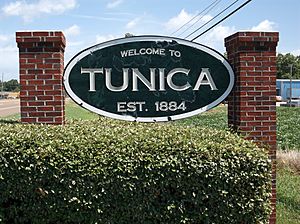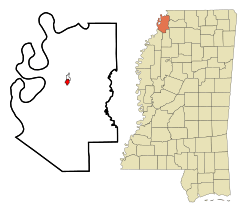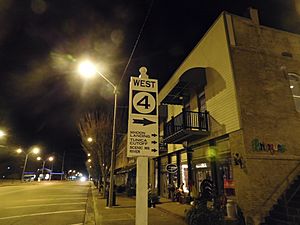Tunica, Mississippi facts for kids
Quick facts for kids
Tunica, Mississippi
|
|
|---|---|
 |
|

Location of Tunica in Tunica County
|
|
| Country | United States |
| State | Mississippi |
| County | Tunica |
| Incorporated | 1884 |
| Area | |
| • Total | 0.66 sq mi (1.72 km2) |
| • Land | 0.66 sq mi (1.72 km2) |
| • Water | 0.00 sq mi (0.00 km2) |
| Elevation | 194 ft (59 m) |
| Population
(2020)
|
|
| • Total | 1,026 |
| • Density | 1,545.18/sq mi (596.88/km2) |
| Time zone | UTC−6 (CST) |
| • Summer (DST) | UTC−5 (CDT) |
| ZIP code |
38676
|
| Area code(s) | 662 |
| FIPS code | 28-74760 |
| GNIS feature ID | 2406764 |
| Website | townoftunica.com |
Tunica is a town in Mississippi, United States. It is the main town, or county seat, of Tunica County, Mississippi. You can find Tunica close to the famous Mississippi River.
For a long time, until the early 1990s, Tunica was one of the poorest places in the United States. But then, casino gambling started in the area. This brought a lot of money and jobs. Even with these improvements, the number of people living in Tunica has slowly gone down since 1970.
Contents
Discovering Tunica's Past
The name Tunica comes from the Tunica Indians. These Native American people used to live in large numbers in this area. Tunica is the fourth town to be the main center for Tunica County. Before Tunica, the county seat was in other places like Commerce, Peyton, and Austin. Tunica officially became a town in 1884.
Tunica became well-known because of a very poor neighborhood called "Sugar Ditch Alley." It got this name from an open sewer there. But things changed for the better in the early 1990s. That's when big gambling resorts were built nearby. Even though most new people moved outside the town of Tunica, the casinos hired many local residents. These casinos bring visitors from nearby cities like Memphis, Tennessee and West Memphis, Arkansas. People also come from all over the Southeastern United States.
Tunica's Location and Weather
Tunica is about 20 miles (32 km) south of Downtown Memphis, Tennessee. The town covers an area of about 0.7 square miles (1.72 square kilometers). All of this area is land.
| Climate data for Tunica, Mississippi (1991–2020 normals, extremes 1959–2019) | |||||||||||||
|---|---|---|---|---|---|---|---|---|---|---|---|---|---|
| Month | Jan | Feb | Mar | Apr | May | Jun | Jul | Aug | Sep | Oct | Nov | Dec | Year |
| Record high °F (°C) | 78 (26) |
81 (27) |
86 (30) |
94 (34) |
98 (37) |
101 (38) |
105 (41) |
106 (41) |
106 (41) |
96 (36) |
86 (30) |
80 (27) |
106 (41) |
| Mean daily maximum °F (°C) | 49.2 (9.6) |
53.7 (12.1) |
62.9 (17.2) |
72.8 (22.7) |
81.6 (27.6) |
89.0 (31.7) |
91.3 (32.9) |
90.9 (32.7) |
86.1 (30.1) |
75.4 (24.1) |
62.5 (16.9) |
52.3 (11.3) |
72.3 (22.4) |
| Daily mean °F (°C) | 40.8 (4.9) |
44.8 (7.1) |
53.5 (11.9) |
62.8 (17.1) |
72.1 (22.3) |
79.6 (26.4) |
82.1 (27.8) |
80.9 (27.2) |
75.3 (24.1) |
64.0 (17.8) |
52.4 (11.3) |
43.9 (6.6) |
62.7 (17.1) |
| Mean daily minimum °F (°C) | 32.5 (0.3) |
35.9 (2.2) |
44.2 (6.8) |
52.8 (11.6) |
62.5 (16.9) |
70.1 (21.2) |
72.9 (22.7) |
71.0 (21.7) |
64.5 (18.1) |
52.6 (11.4) |
42.4 (5.8) |
35.4 (1.9) |
53.1 (11.7) |
| Record low °F (°C) | −5 (−21) |
2 (−17) |
7 (−14) |
27 (−3) |
37 (3) |
46 (8) |
53 (12) |
50 (10) |
37 (3) |
27 (−3) |
15 (−9) |
−10 (−23) |
−10 (−23) |
| Average precipitation inches (mm) | 4.65 (118) |
4.95 (126) |
5.80 (147) |
6.02 (153) |
6.00 (152) |
4.28 (109) |
4.01 (102) |
3.15 (80) |
3.33 (85) |
3.86 (98) |
4.80 (122) |
5.66 (144) |
56.51 (1,435) |
| Average snowfall inches (cm) | 0.4 (1.0) |
0.5 (1.3) |
0.1 (0.25) |
0.0 (0.0) |
0.0 (0.0) |
0.0 (0.0) |
0.0 (0.0) |
0.0 (0.0) |
0.0 (0.0) |
0.0 (0.0) |
0.1 (0.25) |
0.0 (0.0) |
1.1 (2.8) |
| Average precipitation days (≥ 0.01 in) | 10.4 | 8.6 | 10.7 | 9.2 | 10.6 | 8.1 | 7.9 | 6.9 | 6.6 | 7.4 | 9.2 | 10.7 | 106.3 |
| Average snowy days (≥ 0.1 in) | 0.3 | 0.3 | 0.0 | 0.0 | 0.0 | 0.0 | 0.0 | 0.0 | 0.0 | 0.0 | 0.1 | 0.0 | 0.7 |
| Source: NOAA | |||||||||||||
Who Lives in Tunica?
The number of people living in Tunica has changed over the years.
| Historical population | |||
|---|---|---|---|
| Census | Pop. | %± | |
| 1890 | 198 | — | |
| 1900 | 485 | 144.9% | |
| 1910 | 555 | 14.4% | |
| 1920 | 955 | 72.1% | |
| 1930 | 1,043 | 9.2% | |
| 1940 | 1,322 | 26.7% | |
| 1950 | 1,354 | 2.4% | |
| 1960 | 1,445 | 6.7% | |
| 1970 | 1,685 | 16.6% | |
| 1980 | 1,361 | −19.2% | |
| 1990 | 1,175 | −13.7% | |
| 2000 | 1,132 | −3.7% | |
| 2010 | 1,030 | −9.0% | |
| 2020 | 1,026 | −0.4% | |
| U.S. Decennial Census | |||
Tunica's Population in 2020
In 2020, the 2020 United States Census counted 1,026 people living in Tunica. There were 501 households and 293 families.
Here's a look at the different groups of people living in Tunica in 2020:
| Race | Num. | Perc. |
|---|---|---|
| White | 602 | 58.67% |
| Black or African American | 345 | 33.63% |
| Asian | 5 | 0.49% |
| Other/Mixed | 33 | 3.22% |
| Hispanic or Latino | 41 | 4.0% |
Casinos and the Local Economy
The casinos have really helped the local economy. They have caused the population to grow in areas outside the main town of Tunica. Since 1990, the name "Tunica" has been linked to several casinos. These casinos are located near the Mississippi River.
However, most of the casinos are actually in a community called Tunica Resorts. This area is about 10 miles north of the town of Tunica. It stretches all the way to the DeSoto County line.
Tunica Resorts used to be called "Robinsonville." But its name was changed in 2005. This was done to make it clear where the casinos were. The casinos have always used the name "Tunica" to identify themselves. The success of these casinos in northern Tunica County led to the closing of earlier casinos. These first casinos were built in the early 1990s. They were located northwest of Tunica town, in an area called Mhoon Landing. This area is now known as North Tunica. These older casinos either closed or moved. Larger resorts opened closer to Memphis to attract more visitors from that big city.
Tunica was lucky because it was not hit by Hurricane Katrina. This hurricane caused a lot of damage to casinos along Mississippi's Gulf Coast. Because of this, some people who usually went to the Gulf Coast casinos started visiting Tunica County instead. This happened while the Gulf Coast casinos were being repaired.
Even though the casinos are not inside the town limits, Tunica town still benefits. It gets money from the taxes the casinos pay. This money has helped improve the public schools and the downtown area. There have also been big improvements to highways like U.S. Route 61. There's even talk about making the Tunica Municipal Airport bigger.
Some residents of Tunica Resorts want their community to become its own town. This would mean they would have their own local government. Then, the new town government would directly get money from casino taxes. This money could be used to build town offices. It could also help build fire and police stations, libraries, and other public buildings.
Learning in Tunica
The Tunica County School District serves the town of Tunica. Students in Tunica attend:
- Tunica Elementary School
- Tunica Middle School
- Rosa Fort High School
There is also a private school called Tunica Academy. It is located in an unincorporated area of Tunica County, close to Tunica.
Famous People from Tunica
Many talented people have come from Tunica, including:
- Brandon Bryant, an NFL football player.
- James Cotton, a famous blues harmonica player.
- Parker Hall, who was named the Most Valuable Player in the National Football League in 1939.
- Charlaine Harris, a best-selling author.
- Donald Hawkins, an NFL football player.
- Benardrick McKinney, an NFL linebacker.
Getting Around Tunica
Tunica Municipal Airport has had flights at different times. Airlines like Pan Am Clipper Connection and Air Tran have offered services using planes like Boeing 727 and Boeing 737 jets. The closest airport with regular flights is Memphis International Airport. It's in Memphis, Tennessee, and is about a 30-minute drive away.
See also
 In Spanish: Tunica (Misisipi) para niños
In Spanish: Tunica (Misisipi) para niños



